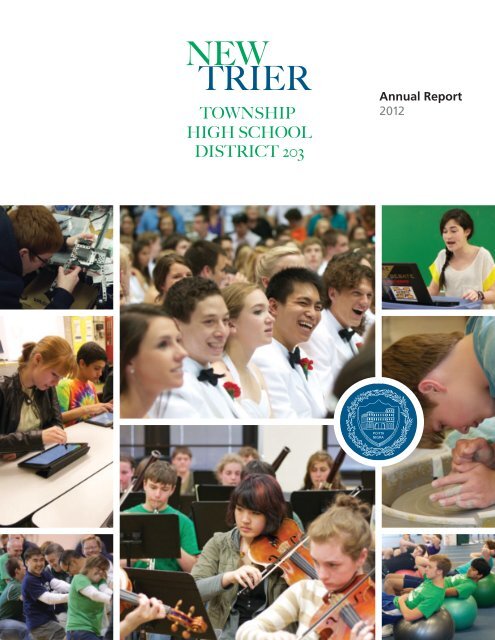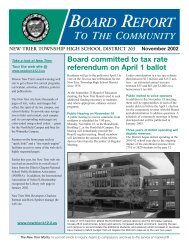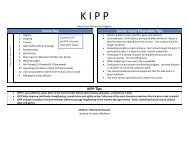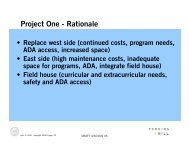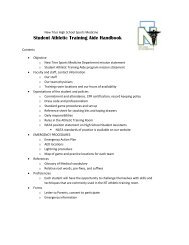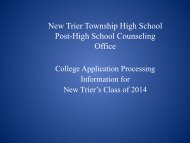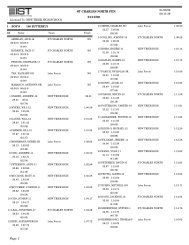Annual Report 2012 - New Trier Township High School
Annual Report 2012 - New Trier Township High School
Annual Report 2012 - New Trier Township High School
- No tags were found...
You also want an ePaper? Increase the reach of your titles
YUMPU automatically turns print PDFs into web optimized ePapers that Google loves.
“To commit minds to inquiry,hearts to compassion,and lives to the service of humanity.”Alan DolinkoBoard President847.784.6108adolinko@robinsoncurley.comMalcolm “Mac” HarrisBoard Vice President847.784.0825mac_harris9@hotmail.comCarol DucommunBoard Member847.256.5418csmme01@aol.comPeter FischerBoard Member847.501.4727peterf1048@aol.comLori GoldsteinBoard Member847.256.6640andylori@aol.comJohn MyefskiBoard Member847.440.8294jmyefski@myefski.comPatrick O’DonoghueBoard Member847.784.6108patricknths@gmail.comNorthfield Campus7 Happ RoadNorthfield, IL 60093847.446.7000www.newtrier.k12.il.usWinnetka Campus385 Winnetka AvenueWinnetka, IL 60093847.446.7000
<strong>New</strong> <strong>Trier</strong> District 203Board of Education:Listening to Our Community<strong>New</strong> <strong>Trier</strong> <strong>High</strong> <strong>School</strong>:Valuing Teaching and LearningDear <strong>New</strong> <strong>Trier</strong> Community Members:In the spring of 2011, the Board of Education received theresults of the <strong>New</strong> <strong>Trier</strong> Community Survey. The survey,sent to all 24,000 <strong>New</strong> <strong>Trier</strong> <strong>Township</strong> households, soughtyour input on issues including District 203 academicperformance, extracurricular opportunities, and facilities.We were pleased that so many of you participated, andsince that time, Board members have worked diligently torespond to the issues, questions, and concerns raised byour fellow community members. We want you to knowwe listened – and are still listening – to you.One survey question asked the areas in which communitymembers would like more information about the District.Two topics rose to the top: finances and facilities. Afterthat, residents also expressed interest in knowing abouthow <strong>New</strong> <strong>Trier</strong> compares to other schools, and the currentbest practices in education.This <strong>Annual</strong> <strong>Report</strong> is one way in which the Districtwill share information with you about these topics.Within this report you will find three full pages on Districtfinances, including charts and graphs with the District’sfinal operating budget.We also have provided an update on the Board’s mostrecent facilities discussions, which have focused on waysto improve access for people with disabilities. Pages onstudent academic performance include charts that compare<strong>New</strong> <strong>Trier</strong> with the rest of the state. There is also an articleon assessing teacher performance that illustrates how<strong>New</strong> <strong>Trier</strong> has led the way in establishing best practices inteacher supervision and evaluation.While the <strong>Annual</strong> <strong>Report</strong> provides basic information onthese topics and more, we know that some communitymembers would like more detail. In those cases, we haveincluded website addresses and QR codes, which can bescanned on mobile devices to take you directly to theareas of our website that address that topic. Our website,newtrier.k12.il.us, contains links to hundreds of historicaland current reports on District finances, academics,curricula, and other topics.We invite you to attend our Board meetings or contact usdirectly at the phone numbers or e-mail addresses providedon the inside cover if you have further questions. Thankyou for your continued support of <strong>New</strong> <strong>Trier</strong> <strong>High</strong> <strong>School</strong>.Sincerely,Alan R. DolinkoBoard PresidentDear <strong>New</strong> <strong>Trier</strong> Residents, Businesses, and Families:Education has been in the news frequently in the pastyear, with pension systems, teacher evaluations, andstudent performance on standardized tests dominating thediscussion. At <strong>New</strong> <strong>Trier</strong>, we have responded by creatingthoughtful ways to comply with state and national educationreform laws while still maintaining the unique aspectsof <strong>New</strong> <strong>Trier</strong> that make it such an outstanding high school.<strong>New</strong> <strong>Trier</strong> is lucky to have a supportive community thatvalues attracting and retaining the highest quality teachers.In the 2011 <strong>New</strong> <strong>Trier</strong> Community Survey, that was the toppriority of our community members. It is also a top priorityof District 203. We believe the academic success wehighlight in the pages of this report reflects directly on ourteachers, who work in partnership with our parents, ourcommunity, our staff, and our administration to providethe best possible education for all of our students.At <strong>New</strong> <strong>Trier</strong>, 95 percent of our teachers hold master’sdegrees or higher, and a large portion of our teachers areinvolved in leadership activities outside of the school. In thepast year, we created a document entitled Characteristicsof Professional Practice at <strong>New</strong> <strong>Trier</strong> <strong>High</strong> <strong>School</strong> thatoutlines in detail what it means to be an effective teacherat <strong>New</strong> <strong>Trier</strong>.The characteristics are organized around four domains:understanding teaching, understanding students, understandingprofessional responsibilities, and understandingthe school and community culture. While each of thesedomains of teaching is distinct enough to describeseparately, all of the domains connect and overlap to setstandards for the quality of teaching we expect all of ourstudents to encounter at <strong>New</strong> <strong>Trier</strong>.We are proud of the role our teachers play in our students’success in and out of the classroom. We are also proudof the opportunities we provide to students through ourrobust academic and extracurricular program and ouremphasis on service learning. You will learn more aboutthese programs throughout this <strong>Annual</strong> <strong>Report</strong>.Most of all, we are proud to work in a community thatsupports our efforts to provide every <strong>New</strong> <strong>Trier</strong> studentwith a high quality educational experience.Sincerely,Dr. Linda YonkeSuperintendent1
<strong>New</strong> <strong>Trier</strong> Leads the Wayon AcademicsAcross the country, <strong>New</strong> <strong>Trier</strong> is synonymous with strongacademic achievement. Many families move to <strong>New</strong> <strong>Trier</strong><strong>Township</strong> because of the school’s broad and diverse curriculum,outstanding teachers, and support for students at all abilitylevels. College representatives seek out <strong>New</strong> <strong>Trier</strong> graduatesknowing that the curriculum prepares them well in areas ofcritical thinking and collaboration.<strong>New</strong> <strong>Trier</strong>’s success in preparing students for their post-highschool pursuits is rooted in the school’s extraordinary academicprogram. Students can choose from seven languages,more than 20 music groups, laboratory sciences rangingfrom forensic science to AP Biology, Project Lead the Wayengineering courses, AP Studio Art, a Great Books course,and so much more.2Class of <strong>2012</strong> ProfileAverage ACT Composite Score: 27.7(state average: 20.6)30 – National Merit Finalists34 – National Merit Semifinalists1 – Presidential Scholar Semifinalist1 – National Achievement Finalist1 – National Hispanic Scholar412 – Illinois State ScholarsAdvanced Placement Exams:823 students took 1,838 AP Exams in spring <strong>2012</strong>95 percent of scores were 3 or better(the typical score necessary to receive collegecredit or placement)• 51 percent of the scores were 5(the highest possible score)• 31 percent of the scores were 4• 13 percent of the scores were 3ACT Achievements for non-AP Students:English:Students who finished Senior year in 3-levelEnglish averaged 28.3 on the English ACT.Math:Students who finished Senior year in 3-levelPre-Calculus averaged 28.1 on the Math ACT.<strong>New</strong> <strong>Trier</strong> students take courses based on a level systemthat translates into college preparatory (2-level), honors(3-level), and highest honors (4-level, including all AP classes).The District is committed to ensuring its academic programfits every student, at every ability level, in every subject.As a result, <strong>New</strong> <strong>Trier</strong> students regularly perform at thevery highest levels on standardized measures of academicperformance such as the ACT college entrance exam.The average composite ACT score for the Class of <strong>2012</strong>was 27.7, the highest in Illinois for an open enrollment(non-magnet) public school and among the top school scoresin the country.A study of the <strong>New</strong> <strong>Trier</strong> Class of <strong>2012</strong> found that high levelsof achievement applied to students in all course levels.For example, students who did not take any AP EnglishACT Assessment: Graduating Class of <strong>2012</strong>*36.032.028.024.020.016.012.08.04.027.720.628.320.10Composite English Mathematics Reading ScienceDistrict27.920.9State27.720.526.620.6* Includes graduating students’ most recent ACT Assessment scores from an ACTnational test date or PSAE testing. Excludes the scores of students who took thetest with special accommodations. State averages for ACT data are based onregular public schools and do not include private and special purpose schools.
courses and finished senior year in 3-level English averaged28.3 on the English ACT, 8 points above the national average.While <strong>New</strong> <strong>Trier</strong> has a rigorous curriculum, it also has a widearray of supports for students who may be struggling with someof their coursework. For example, the Academic AssistanceCenter on the Northfield Campus is staffed mainly by retiredteachers who help students with a variety of subjects before,during, and after the school day.Teachers on both campuses have open-door policies andencourage students to drop in whenever they might havea question about an assignment or test. Department offices area beehive of activity, and students can be seen consultingwith teachers every period. Visitors from other schools regularlyremark on how unusual it is to see high school students soengaged with their teachers outside of the classroom.<strong>New</strong> <strong>Trier</strong> also has an active peer-tutoring program and adrop-in Reading and Writing Center on the Winnetka Campusstaffed during the school day by students trained in helpingtheir peers with those subjects. All of these supports existoutside of the Special Education program, which offersassistance for students with identified needs.The success of <strong>New</strong> <strong>Trier</strong>’s academic program is reflected in theschool’s surveys of its graduates, who regularly report feelingvery well-prepared for college. The results of the most recent<strong>New</strong> <strong>Trier</strong> Graduate Survey found:• <strong>New</strong> <strong>Trier</strong> graduates indicated that they were extraordinarilywell prepared for English/Writing; they also rated theirpreparation in Science very highly.• 96 percent of graduates said they were prepared or veryprepared for college academic work.• <strong>New</strong> <strong>Trier</strong> graduates also said they were especiallywell-prepared in the areas of critical thinking (80 percent),academic expectations (75 percent), and study skills(69 percent). When graduates were asked to indicate in whichof seven areas they were not well-prepared, 40 percentof students said there was NO area in which they were notwell-prepared for college.<strong>New</strong> <strong>Trier</strong> administrators recently presented the results ofthe <strong>New</strong> <strong>Trier</strong> Graduate Survey to a consortium of otherhigh-performing suburban school districts from around thecountry. <strong>New</strong> <strong>Trier</strong> graduates compared favorably to thosein other districts in their assessment of their preparation forcollege, generally scoring higher in areas asking aboutacademic preparation.<strong>New</strong> <strong>Trier</strong> graduates’ positive responses about English/Writingin particular were far higher than any of the other districts,even though only 39 percent of <strong>New</strong> <strong>Trier</strong> graduates respondinghad taken an AP English class. Such responses are an indicationthat <strong>New</strong> <strong>Trier</strong> offers a rigorous curriculum for students atall levels.<strong>New</strong> <strong>Trier</strong> is committed to supporting all students in pursuingtheir academic and elective interests, and giving them theassistance they need along the way. The results are seen notjust in the performance of current students, but in the feedbackstudents give about their preparation for their lives afterhigh school.3
District 203 Budget:Strong Fiscal ManagementSources of Revenues1.3% 2.7%4.4%91.6%District 203 recognizes that the resources it uses to offerstudents one of the best public school experiences in thecountry come primarily from its local taxpayers. <strong>New</strong> <strong>Trier</strong>would not exist without the partnership it enjoys with thiscommunity. The Board of Education and administrationwork hard to protect the investment of District 203 taxpayers,with a goal of keeping tax rates at the current level for asfar into the future as possible.Property TaxesState SourcesLocal SourcesFederal Sources“This award represents a signif icantachievement and reflects your commitmentto the highest standards of school systemfinancial reporting.”Expense by Type6.8% 13.6%69.0%4.5%3.1%2.7% 0.2%Salaries Employee Benefits Purchase ServicesSupplies Capital OutlayTuition Dues/Fees/Debt– The Association of <strong>School</strong> Business Officials International, presenting District 203with its Certificate of Excellence in Financial <strong>Report</strong>ing for the 10th consecutive year.Illinois law limits the amount school districts can levy withouta referendum to a percentage based on the ConsumerPrice Index or 5 percent, whichever is less. Despite theselimitations, District 203 has requested a tax rate referendumfor operational expenses only twice in the last 35 years,most recently in 2003 during a period of rapid studentenrollment growth.The most recent five-year projections for District 203 showthat the District can continue to balance its budget withouta tax rate referendum. While state legislation surroundingpensions and other school employee expenses makes futurebudgeting uncertain, District 203 continues to expect thatits strong financial management will protect taxpayers andserve students well into the future.4FY <strong>2012</strong>-2013 Final Operating Budget (in millions)Fund Revenues* Expenses*Educational $81.8 $81.2Operations & Maintenance $8.3 $7.5Transportation $1.7 $1.9Municipal Retirement $3.4 $3.3TOTAL Operating Funds $95.2 $93.9The District’s Operating Budget includes allOperating Funds, which represent the vastmajority of the District's overall budget.The District also maintains non-operatingfunds, including Debt Services, CapitalProjects, and Fire Prevention and Safety.*Includes transfers
The charts and graphs on these pages outline the District’sfinal budget numbers for the <strong>2012</strong>-2013 school year andshow the most significant sources of District funding andthe main categories of expense.The District has received accolades for its robust DistrictFinancial Information website, where financial reports anddocuments supporting <strong>New</strong> <strong>Trier</strong>’s budget planning areregularly updated. The website includes links to Board ofEducation documents and information on each year’sbudget-building process. It also features several years’worth of budget documents, including:• Budget summaries for each year• Illinois State Board of Education budget reports• <strong>Annual</strong> Financial <strong>Report</strong>s• Monthly Financial <strong>Report</strong>s• Bill Lists• Contracts and Compensation <strong>Report</strong>sTo explore these reports, visit the Board of Education pageof the main <strong>New</strong> <strong>Trier</strong> website, http://newtrier.k12.il.us/,or use your mobile device to scan this QR code and directlyaccess the page:<strong>New</strong> <strong>Trier</strong>’s Comprehensive <strong>Annual</strong>Financial <strong>Report</strong> (CAFR) “has been judgedby an impartial panel to meet the highstandards of the program, includingdemonstrating a constructive ‘spirit of fulldisclosure’ to clearly communicate itsfinancial story and motivate potential usersand user groups to read the CAFR.”– The Government Finance Officers Association of the United States and Canada,in awarding its highest honor to District 203.Financial Recognitionfor District 203District 203 is committed to transparency and thehighest standards of financial management.These independent groups have recognized theDistrict for its outstanding work on budgetingand financial reporting:Aaa bond rating – Moody’s Investors Servicesreaffirmed this bond status in April 2010; <strong>New</strong><strong>Trier</strong> was the first school district in Illinois toachieve the top rating.Illinois State Board of Education FinancialRecognition – District 203 has received ISBE’shighest Financial Profile designation for nineconsecutive years.Government Finance Officers Association of theUnited States and Canada (GFOA), Certificateof Achievement for Excellence in Financial<strong>Report</strong>ing – Nine consecutive yearsAssociation of <strong>School</strong> Business OfficialsInternational, Certificate of Excellence inFinancial <strong>Report</strong>ing – Ten consecutive years5
Assessing TeacherPerformance at <strong>New</strong> <strong>Trier</strong>On last year’s community survey, District 203 residentsindicated that their top priority for the future of <strong>New</strong> <strong>Trier</strong><strong>High</strong> <strong>School</strong> is to recruit and retain high quality teachers.The next two priorities listed by residents are to provide asafe and respectful learning environment and to maintainthe most rigorous instruction possible – both inextricablylinked to teacher performance. The community rated thequality of <strong>New</strong> <strong>Trier</strong> as excellent and expressed a desire forall teachers to be held to the highest standards.Accountability for teacher performance is also a priorityof the state of Illinois, as seen in school reform legislationpassed last year. The Illinois law requires each district toreview standards for teacher evaluation as well as toimplement extensive new training for those who evaluateteachers. Changes in state law now give added weight toteacher performance – rather than seniority alone – whenreduction-in-force takes place, and require that studentacademic growth be considered in teacher evaluation inthe future.During the past year, a committee of <strong>New</strong> <strong>Trier</strong> administratorsand teachers carefully revised and updated its framework forbest practices in teaching, the Characteristics of ProfessionalPractice, containing the school’s standards and indicatorsof excellence. The characteristics are organized into fourdomains: Understanding Teaching, Understanding Students,Understanding Professional Responsibilities, and Understandingthe <strong>School</strong> and Community Culture. The teacherevaluation process at <strong>New</strong> <strong>Trier</strong> takes into account teacherperformance in each of these domains.Hiring the very best teachers is a focus of the school’srecruitment program, but support, assessment, anddevelopment of teachers throughout their careers is alsoof critical importance to ensuring quality teaching. Theprofessional development program provides support forteacher growth and continuous learning; the evaluationsystem rigorously assesses teacher performance.<strong>New</strong> <strong>Trier</strong>’s teacher evaluation system is one way the Districtseeks not just to meet, but to exceed the state’s criteria forexcellence in teaching. The school’s merit pay system, inplace since the mid-1960s, provides another method ofclosely examining teacher performance. No teacher canadvance past a certain point in the pay schedule unlesshe/she demonstrates that he/she is a master teacher; no onecan advance to the highest lane in the pay scale withoutdemonstrating continued mastery of teaching as well asleadership within the profession. The process of determiningwhether someone is a master teacher includes self-reflection,written documentation from the teacher’s supervisor,extensive peer review, and a presentation to the PermanentEvaluation Committee. Tying teacher performance to salaryadvancement is more effective than simply rewardingteachers for the length of their teaching career or their levelof education.Master Teachers at <strong>New</strong> <strong>Trier</strong> must “consistently demonstratea level of excellence, characterized by a vitality and enthusiasmfor their work that ensures freshness of approach andconstant creative efforts. …” Leader teachers are masterteachers who also embody the “leadership qualities thattranscend assigned responsibilities.”The merit pay system helps the District set and maintain highexpectations for teacher performance. When a prospectiveteacher applies to work at <strong>New</strong> <strong>Trier</strong>, interview committeesconsider whether that teacher is, or has the potential tobecome, a Master Teacher. Teachers hired at <strong>New</strong> <strong>Trier</strong> shapetheir careers with the knowledge that they will have todemonstrate mastery of their professional skills in order toadvance on the salary schedule. Teachers know that theymust develop their content knowledge, teaching skills,understanding of students, and relationships with parents,and that they must be able to demonstrate the highest levelsof knowledge and skill in each area. Teachers who wish toadvance even further must be willing to take on leadershipresponsibilities in the school and in their profession.<strong>High</strong>ly effective teachers choose <strong>New</strong> <strong>Trier</strong> because it is awonderful place to teach, with its hard-working students,supportive parents, and generous community. But anotherreason that <strong>New</strong> <strong>Trier</strong> attracts and keeps talented teachersis that the school establishes high standards for excellence,supports teachers throughout their careers, and fostersleadership within a corps of professionals who contributenot only to the <strong>New</strong> <strong>Trier</strong> community, but to the professionat large.7
<strong>New</strong> <strong>Trier</strong> ConsidersAccessibility at CampusesIn the spring of 2011, following extensive research onaccessibility issues at <strong>New</strong> <strong>Trier</strong>’s two campuses, theDistrict formed a school-community task force to developrecommendations for making the school buildings moreaccessible to people with disabilities.The issue of accessibility is just one of the facilities concernsthe Board of Education has been studying since a failedfacilities referendum in 2010. Other issues include themaintenance of aging buildings, particularly on the WinnetkaCampus, where the last major renovation and constructionproject was completed in 1957.<strong>New</strong> <strong>Trier</strong> Facilities ResearchIn the Summer of 2011, <strong>New</strong> <strong>Trier</strong> administratorspresented the Board of Education with a number ofreports meant to address the top facilities questionsand concerns identified by community members inthe 2010 <strong>New</strong> <strong>Trier</strong> Community Survey.Those reports include:• Long-Range Facilities Plan: A plan adopted by theBoard of Education in 2009 incorporating three years ofresearch by District committees• 1:3 Model Study: Research on the freshman/upperclassman campus model in place at <strong>New</strong> <strong>Trier</strong>since 2001• Land, Building, and Field Use: A presentation on theuse, condition, and availability of space at <strong>New</strong> <strong>Trier</strong>’stwo campuses• Field Use Update: An update on the use of playing fieldsboth at <strong>New</strong> <strong>Trier</strong>’s campuses and at off-campus facilities• ADA memo: A report on Americans with Disabilities Actaccessibility at <strong>New</strong> <strong>Trier</strong>’s campuses and work thathas been done in the past several years to comply withfederal lawThe District has created a website that serves as aone-stop shop for all of this research. To learn more, visithttp://newtrier.k12.il.us/facilitiesresearch/ or scan thefollowing QR code on a mobile device:The ADA Task Force reported back to the Facilities SteeringCommittee with a number of recommendations on improvingaccessibility. The Task Force toured every part of both campusesto identify accessibility needs, then prioritized those needsand possible solutions. The Facilities Steering Committeelooked at their work and came up with these suggestions:• Explore the feasibility and cost of an elevator in theGates Gymnasium on the Winnetka Campus.• Research solutions for ADA issues in the Gaffney Auditorium(Winnetka) and Cornog Auditorium (Northfield).• Consider another elevator in the North/Tower buildings torelieve pressure at the Winnetka Campus, where a singleelevator is used for both passengers and freight on acampus with more than 755,000 square feet.The Steering Committee is considering conceptual solutionsto these issues, and the Board will decide whether to pursueany proposals as part of a long-term approach to facilities at<strong>New</strong> <strong>Trier</strong>.At the same time, the Board continues to look at <strong>New</strong> <strong>Trier</strong>’slong-range facilities plan to address other areas of need onits campuses. Maintenance remains an issue at the WinnetkaCampus. While <strong>New</strong> <strong>Trier</strong>’s staff has done an excellent jobkeeping up with repairs on buildings ranging from 50-100years old, sometimes costly issues remain.For example, the District began work this summer on neededreplacement of windows at the Gates Gymnasium on theWinnetka Campus, typical for a gym built in 1928. The projectwas awarded through a bidding process and had a budgetof $373,000.However, when work began, the contractors discovered thatthe structural areas supporting the windows had deterioratedsignificantly more than expected and needed to be replaced,increasing the project budget by almost 20 percent.Based on the response of the community to the 2010referendum, the Board has been considering the benefits ofa series of smaller projects over time rather than one largeproject that addresses every need.8
<strong>New</strong> <strong>Trier</strong> Goes Mobilewith iPad ProjectWalk through the halls of <strong>New</strong> <strong>Trier</strong> this school year, and you willsee hundreds of students using the equivalent of a high-techmobile classroom: an iPad.<strong>New</strong> <strong>Trier</strong> began exploring iPads as part of its Mobile LearningInitiative, through a committee of faculty and staff charged withdetermining the best educational uses for mobile devices suchas smartphones and tablets that already are very familiarto high school students.Approximately 650 students in about 20 courses – or about 15percent of students overall – are participating in a pilot projectto explore the use of iPads in and out of class. Students wereassigned to participate based on whether they had signed upfor courses approved for the iPad project, and families had thechoice of using District-owned iPads, purchasing the devicesfrom the District, or providing their own.Teachers are using the audio, video, and photo capabilities ofthe iPads as well as applications (apps) to enhance their lessons.For example, students in a Chinese language class can reviewcharacters and hear words spoken with one app, and Anatomyand Physiology students have combined another app with theiPad camera to create a kind of digital microscope. In a SportsMedicine/Kinesiology course, the teacher made a video of hisdemonstration of an ankle-wrapping exercise so that studentscould watch, pause, and take notes on their own iPads as theypracticed the exercise themselves.An initial survey of students, parents, and teachers foundwidespread enthusiasm for the project and its potential academicbenefits. More than half of the students surveyed said theybelieved they would use the iPad in most of their classes, and 80percent thought they would use the devices for the majority oftheir research.The iPads were purchased using Technology funds that wouldhave been used this year to replace existing desktops or laptops.The District is studying whether tablets can take the place ofsome of those other forms of technology in the long-term.Families who choose the District devices pay a mandatoryinsurance fee to cover breakage or replacement.<strong>New</strong> <strong>Trier</strong> also continues to see success with its innovativeclassroom project, which launched in the 2010-2011 school year.The District has renovated four spaces into 900-square-footclassrooms outfitted with multiple screens, chairs and desks thatare designed for collaboration, as well as class sets of iPads orlaptops and portable whiteboards for group work.While the District has exhausted the spaces available to createmore of these types of classrooms, it has expanded the projectby bringing the innovative furniture and additional technologyinto other existing spaces. The ability to continue to expand,though, is limited by the large number of small classrooms at<strong>New</strong> <strong>Trier</strong>, which cannot accommodate the larger furniture oradditional screens. The committee continues to explore ways tobring innovation to all classrooms.9
RegistrarAssistantPrincipalAcademicClassesStudentAssistanceCoordinatorSpecialEducationServicesSpotlight On: The <strong>New</strong> <strong>Trier</strong>Adviser SystemOutsideAgenciesPost-<strong>High</strong><strong>School</strong>ServicesPsychiatristPsychologistsAdviseeAdviserAdviser ChairHealthServicesAthleticsSpeechTherapistsSocialWorkersGuidanceTeamsCo-CurricularActivitiesTestingServices<strong>New</strong> <strong>Trier</strong> students experience many changes during theirfour years of high school as they move toward independenceand adulthood. But they can rely on one constant: the smallgroup of classmates with whom they begin each day. This isthe <strong>New</strong> <strong>Trier</strong> adviser system, and it has been a model for highschool advisement since it began in 1928.<strong>New</strong> <strong>Trier</strong> always has recognized the need for high schoolstudents to connect with and trust an adult mentor at school.The District believes that the best person to provide guidanceand support is a faculty member who sees each advisee dailyand who stays with those students throughout their highschool experience.Students Are the Centerof the Adviser SystemMaking a Big <strong>School</strong> Feel SmallWith a student body topping 4,200 students, <strong>New</strong> <strong>Trier</strong> maybe large, but the school strives to give each student anindividualized experience. In addition to the programshighlighted on these pages, <strong>New</strong> <strong>Trier</strong> makes a big schoolfeel small in the following ways:• Post-<strong>High</strong> <strong>School</strong> Counseling: From sophomore throughsenior year, post-high school counselors work to helpstudents identify, plan for, and pursue their passions aftergraduation. Individual counseling sessions begin in thejunior year.• Freshman Campus Transition Coordinator: The TransitionCoordinator helps prepare junior high students and theirparents for <strong>New</strong> <strong>Trier</strong> by collecting information from senderschools and reviewing freshman course options andschedules with families. <strong>New</strong> <strong>Trier</strong> also hosts a number ofinformational nights for new students and parents onsubjects such as activities, special education, athletics,and placement.• Student Clubs: One of the advantages of attending a bigschool is that students can find groups of like-mindedfriends who share an interest in everything from roboticsto dance to pottery. With about 170 clubs, <strong>New</strong> <strong>Trier</strong>makes sure every student has a place to fit in.• Extracurricular opportunities: <strong>New</strong> <strong>Trier</strong> offers intramuralteams, performing arts opportunities, and 35 interscholasticsports throughout the school year. No-cut sports are offeredeach season, and many sports carry multiple team levels andlarge squads to give more students an opportunity to play.Performing Arts also offers no-cut theatre opportunitiessuch as improv troupes. Theatre productions that dorequire auditions are often double cast to let more studentstake the stage.Advisers make this connection in adviser room, a 25-minuteperiod that begins each day at <strong>New</strong> <strong>Trier</strong>. About 25 students,all of the same gender, are assigned to one adviser roomthat will stay together during all four years of high school.<strong>New</strong> <strong>Trier</strong> takes care to assure that the rooms have studentsfrom different communities, of different ability levels, andwith different interests. Many students make lifelong friendsin their adviser rooms.The adviser provides a crucial school-home link, acting as thefirst resource for students and their parents in matters ofpersonal adjustment and academic counseling. Students areassigned to a freshman adviser on the Northfield Campusand a second adviser on the Winnetka Campus who will staywith them for sophomore through senior year.The adviser room provides an antidote toanonymity, a home away from home. It is acomfort for students to begin each day with a mentorin whom they can conf ide, and an advocate onwhom they can rely for advice and support.Advisers – in partnership with parents – help students createa four-year academic plan at <strong>New</strong> <strong>Trier</strong>, select extracurricularactivities that suit their interests, and prepare for life after highschool. During the sophomore year, advisers visit advisees andtheir parents at home to further build personal relationships andto make sure each student has an individualized experience.The adviser system is overseen by one boys’ chair and onegirls’ chair for each year group. Chairs meet regularly withadvisers to develop programs for adviser groups, shareinformation about school initiatives, and develop discussiontopics. Adviser chairs also administer discipline and helpstruggling students connect with school resources.<strong>New</strong> <strong>Trier</strong> is proud of its adviser system and the important roleit plays in building relationships between students, parents,and the adults who work in the school.10
Spotlight On: IntegratedGlobal Studies <strong>School</strong>Each day for three or four class periods, about 80 <strong>New</strong> <strong>Trier</strong>juniors and seniors attend a different school than the rest oftheir <strong>New</strong> <strong>Trier</strong> classmates, yet they do so without ever leavingthe Winnetka Campus.The Integrated Global Studies <strong>School</strong> (IGSS) is a school-within-aschoolestablished in the 2008-2009 school year to give studentsan opportunity to learn a variety of disciplines within a smallschoolsetting. IGSS students meet for three to four periodsin a row each afternoon, and their curriculum, developed bystudent leaders in partnership with faculty co-coordinators,offers credit in English, social studies, science, and the arts.Much of the curriculum is project-based, with students learningaround an annual co-curricular theme such as “Justice on thisPlanet” or “The Human Legacy.” The IGSS values experientiallearning, and students are encouraged not just to research andstudy, but also to do something to share their learning withthe greater community.One student interested in the phenomenon of declininghoneybee populations produced a short film on the issue andbecame a beekeeper herself. Another student worked to createan organic garden on the grounds of the Winnetka Campus.She became versed in facilities challenges, permits, and issuessurrounding the installation and maintenance of such a largeproject. The garden has flourished, and current studentscontinue to maintain it.Feedback from IGSS students and parents has been extraordinarilypositive. Students appreciate the flexibility the program offersand the ability to set their own course of learning, and severalparents have commented on how their students found theirpassion during their time in the program. Graduates have goneon to prestigious universities, large state schools, and smallliberal arts colleges.Students must apply for admission to IGSS, and faculty selecteach class based on student applications, teacherrecommendations, and personal interviews.More information can be found athttp://newtrier.k12.il.us/page.aspx?id=11543or by scanning this QR code on your mobile device:The IGSS Mission:The Integrated Global Studies <strong>School</strong> is designed to provide a smallschool setting for students who are passionate about learningand who wish to help direct the path of their own education. Ourschool-within-a school is a challenging opportunity for students andstaff to examine connections within and across disciplines and todevelop creative and experiential courses of study. The IGSS is drivenby individuals whose open-mindedness inspires the spirit of inquiry,whose personal involvement is fueled by compassion, and whoseconvictions lead them to be responsibly active, both locally andglobally, in the world outside the walls of <strong>New</strong> <strong>Trier</strong>.11
Committing Lives to Serviceat <strong>New</strong> <strong>Trier</strong> and BeyondService is embedded into the <strong>New</strong> <strong>Trier</strong> motto: “To commitminds to inquiry, hearts to compassion, and lives to the serviceof humanity.” It is no surprise, then, that students spend asignificant amount of time working on service projects bothin and out of the classroom during their years at <strong>New</strong> <strong>Trier</strong>.A recent District analysis found that simply by taking partin class service projects and the school’s service-learningcurriculum alone, the average <strong>New</strong> <strong>Trier</strong> student experiencesabout 56 hours of service in four years. That does not countextracurricular activities such as service clubs.<strong>New</strong> <strong>Trier</strong> has a long history of student service. The school’soldest clubs, Girls Club and Tri-Ship, were established topromote student leadership through service to the community,the greater Chicago area, and the world.Today, <strong>New</strong> <strong>Trier</strong> students participate in service in three mainways: through community service, service learning andcampus-wide projects.Community service includes gathering supplies, raisingmoney, or volunteering for a specific cause. One example isthe senior project to build a home with Habitat for Humanity.Service-learning projects tie together a curricular goal witha service experience. For example, last year, some Englishstudents studying poverty in the United States volunteered ata local soup kitchen and wrote letters to the governor aboutpoverty legislation.Campus-wide projects involve an entire class, campus, orthe whole school. The Northfield Campus recently completeda service-learning project on Haiti and will focus on a schoolin India starting this year.Thank You for Your Support of the Haiti Project12We humbly thank the <strong>New</strong> <strong>Trier</strong> faculty, staff, students andthe extended <strong>New</strong> <strong>Trier</strong> Community for their generosityand compassion in helping to rebuild St. Joseph Elementary<strong>School</strong> in Petit-Goave, Haiti. In January 2010 an earthquakedevastated Haiti and destroyed the entire school. Many adviserrooms, clubs and other groups responded with donations andoffers of help.Inspired by our personal financial support of the school in ourHaitian hometown of Petit-Goave, <strong>New</strong> <strong>Trier</strong> launched the HaitiProject in September 2009 as a service-learning project on theNorthfield Campus. After the earthquake, the focus changed toa school-wide effort to aid Petit-Goave and rebuild the school.Within a year the <strong>New</strong> <strong>Trier</strong> Community reached its goal of$100,000 and in <strong>2012</strong> raised an additional $25,000 to completeconstruction and furnish the school with blackboards, desks,and other needed items.We would like to extend a special thank you to Little by Little(Glenview), John Hersey <strong>High</strong> <strong>School</strong>, (Arlington Heights),Skokie Elementary <strong>School</strong> (Winnetka), St. Joseph Parish(Wilmette), Thomas Middle <strong>School</strong> (Arlington Heights),Crow Island <strong>School</strong> (Winnetka), The Mather Place (Wilmette),Architecture for Humanity (Chicago), and the Kretchmer Family.We are proud to report that St. Joseph Elementary <strong>School</strong>reopened this October. Our dream was to rebuild the school,and thanks to the bigheartedness of the <strong>New</strong> <strong>Trier</strong> Communitythat dream has come true, and the students will be provideda quality education in a safe environment that will allow thema bright future.Thank you,Maurice Bonhomme & Jean CayemitteSecurity Staff, <strong>New</strong> <strong>Trier</strong> <strong>High</strong> <strong>School</strong>
<strong>New</strong> <strong>Trier</strong> Turf Project:A Public-Private PartnershipIf you drove by the Northfield Campus of <strong>New</strong> <strong>Trier</strong> thissummer, you might have wondered about all the heavyconstruction equipment and growing mounds of earth nextto the competition stadium. In just a few short months –and in time for the return of students in August – the Districtreplaced the natural turf on its playing fields with moredurable synthetic turf, joining the majority of its neighboringdistricts in making the switch.The change has resulted in an eightfold increase in the use ofthe stadium field, and has more than doubled the use of theadjacent practice fields. With natural turf, the stadium wasused only for 4-5 football games and a few varsity soccergames a year. Now sports such as field hockey and physicaleducation classes use the field daily. Physical educationstudents, athletic teams, intramural squads, and communitymembers also are using the adjacent large playfields every day,increasing the use of all fields by hundreds of hours a year.The project came about in large part due to the passionand generosity of the <strong>New</strong> <strong>Trier</strong> Booster Club. The Boosterspledged to contribute $1 million toward the $3.3 millionproject and have already raised $400,000 through their“Tackle the Turf” fundraising campaign.The District has been studying the advantages of switchingto all-weather synthetic turf since at least 2003, and addingsynthetic turf is part of the District’s long-range facilities plan.A committee of teachers and coaches found that use of thestadium field would increase from 250 hours a year to almost2,000 hours after the installation of synthetic turf, while useof the practice fields would increase from less than 1,000hours to more than 2,000 hours a year.The Booster Club’s $1 million commitment is the largestdonation ever offered to <strong>New</strong> <strong>Trier</strong> <strong>High</strong> <strong>School</strong>. In addition,the District negotiated a historically low 1.275 percentfinancing rate over a five year period for a lease-financingagreement.<strong>New</strong> <strong>Trier</strong> estimates it will save at least $563,929 in maintenancecosts over 12 years by switching to synthetic turf and gainadditional revenue of approximately $377,400 during thattime period by renting the fields to outside organizations.<strong>New</strong> <strong>Trier</strong> Booster ClubThe <strong>New</strong> <strong>Trier</strong> Booster Club has evolved over the years fromits beginnings as an organization known as the Dad’s Club,through its period as the <strong>New</strong> <strong>Trier</strong> Club and into what isnow officially and legally the <strong>New</strong> <strong>Trier</strong> Booster Club. Theorganization transitioned from a football-only group in1980 to a parent organization focused on supporting allextracurricular activities, with a primary focus on athletics.The early success and support of the football program bythe Dad’s Club continued with the <strong>New</strong> <strong>Trier</strong> Club, whichprovided small scholarships to a limited number of footballplayers. In 1993, the Club’s Board began to broaden thebase of activities supported by its efforts, and the Club wasregistered as a 501(c)(3) organization.Today, the <strong>New</strong> <strong>Trier</strong> Booster Club is a parent-runorganization devoted to supporting <strong>New</strong> <strong>Trier</strong> extracurricularactivities not funded through the normal school operatingbudget. The Club provides intramural sports programs inTennis, Golf, Basketball and Volleyball, with over 1,000Trevians participating each school year.The Booster Club is working toward a $1 million fundraisinggoal through its “Tackle the Turf” campaign. Donors canpurchase inscribed bricks for $100 or $500 to be laid in awalkway at the <strong>New</strong> <strong>Trier</strong> competition stadium or donateany amount toward the effort. More information can befound at http://newtrier.k12.il.us/tackletheturf/ or byscanning this QR code on your mobile device:13
Non-ProfitOrganizationU.S. PostagePAIDPermit No. 319Winnetka, Illinois385 Winnetka AvenueWinnetka, IL 60093-4295<strong>New</strong> <strong>Trier</strong> <strong>Township</strong> <strong>High</strong><strong>School</strong> District 203 is onFacebook and Twitter. “Like”us on Facebook and follow uson Twitter to find out aboutschool news, links to reportsfrom the Board of Education,upcoming events, and otherinformation. <strong>New</strong> <strong>Trier</strong> alsoshares news, reports, andinformation on its website,www.newtrier.k12.il.us. Eachmonth, the District sendsout a “Board of Educatione-<strong>New</strong>s” report summarizingthe votes and discussionsat each regular Board ofEducation meeting. To signup for these reports, pleasesend an e-mail todizonn@newtrier.k12.il.us.Produced by theDepartment of Communications& Alumni RelationsDirector:Niki DizonDesign:Jason Feldman, Luzazul DesignPhotography:Lois Bernstein PhotographyThe <strong>New</strong> <strong>Trier</strong> Motto:To commit minds to inquiry,hearts to compassion, and livesto the service of humanity. ®


